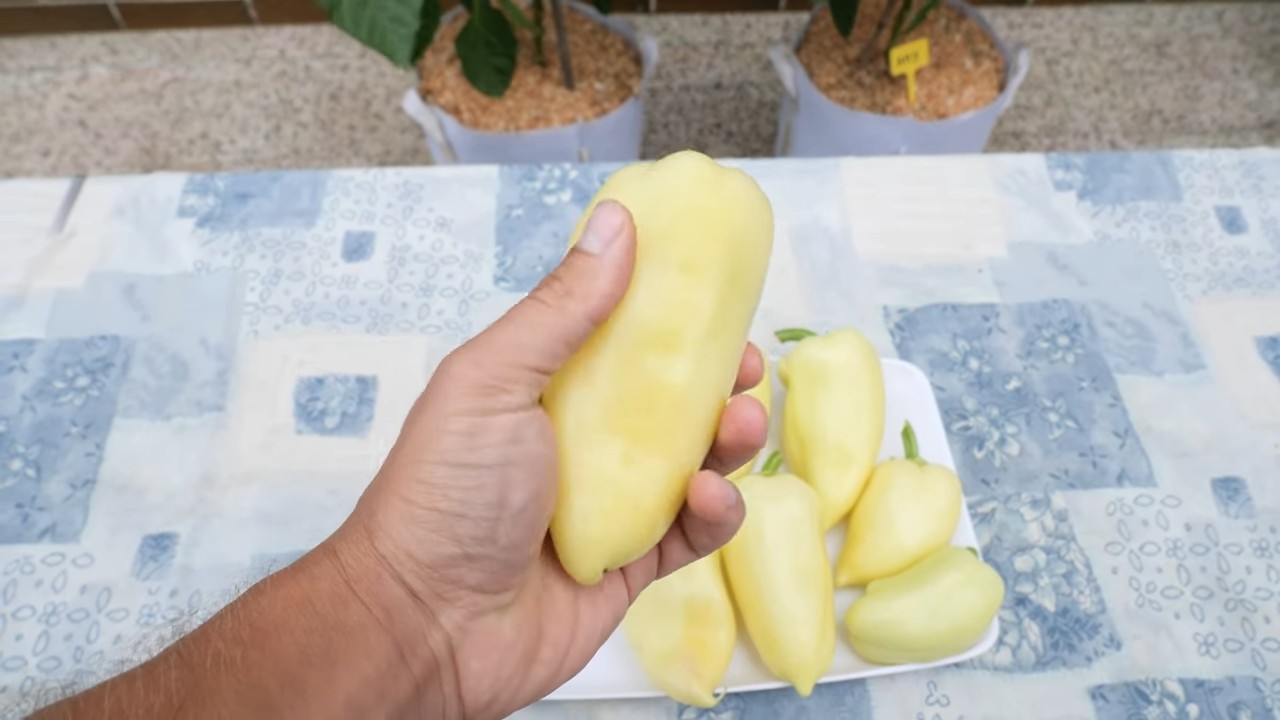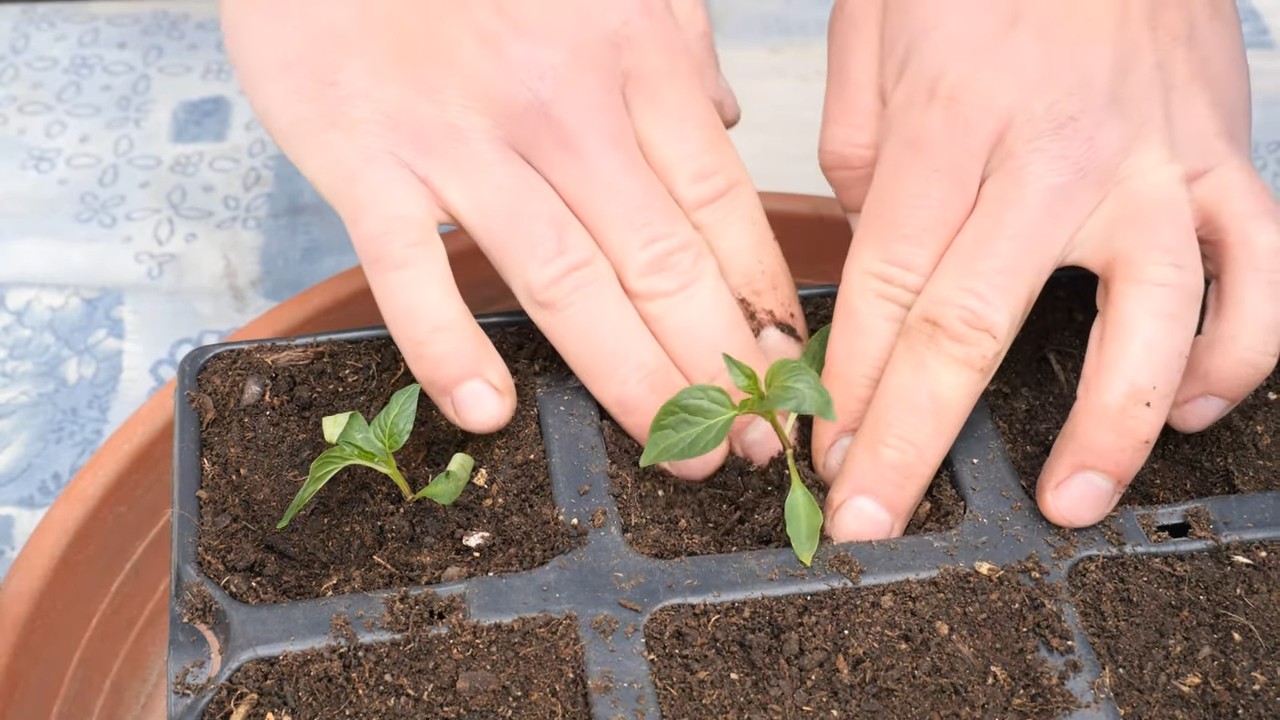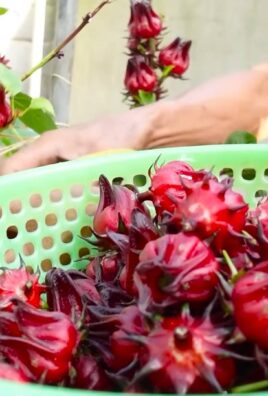Grow Sweet Peppers at Home and unlock a world of vibrant flavors right outside your door! Imagine biting into a juicy, sun-ripened sweet pepper, bursting with freshness, knowing you nurtured it from seed to table. Forget those bland, store-bought peppers – this year, we’re taking control and cultivating our own delicious bounty.
For centuries, peppers have been cherished across cultures, from their fiery origins in South America to their adoption into cuisines worldwide. They’re not just a culinary staple; they’re a symbol of warmth, spice, and the joy of homegrown goodness. But let’s be honest, sometimes getting those peppers to thrive can feel like a real challenge. That’s where these DIY tricks and hacks come in!
Are you tired of struggling with stunted growth, blossom end rot, or pest infestations that threaten your pepper plants? I know I have been! That’s why I’ve compiled a collection of simple, effective, and budget-friendly solutions to help you grow sweet peppers at home like a pro, even if you’re a complete beginner. We’ll cover everything from soil preparation and watering techniques to natural pest control and maximizing your pepper yield. Get ready to transform your garden into a sweet pepper paradise!

Growing Sweet Peppers at Home: A Beginner’s Guide
Hey there, fellow gardening enthusiasts! I’m so excited to share my tried-and-true method for growing delicious, sweet peppers right in your own backyard (or even on your balcony!). Forget those bland, overpriced peppers from the grocery store – with a little patience and these easy steps, you’ll be harvesting a bounty of colorful, flavorful peppers in no time.
Choosing Your Pepper Varieties
Before we dive into the nitty-gritty, let’s talk about pepper varieties. Sweet peppers come in a rainbow of colors and shapes, each with its own unique flavor profile. Here are a few of my favorites:
* Bell Peppers: The classic choice! They come in green, red, yellow, orange, and even purple. Red and yellow bell peppers are generally sweeter than green ones.
* Banana Peppers: Mild and slightly tangy, these are great for pickling or adding to sandwiches.
* Pimiento Peppers: Sweet and heart-shaped, perfect for stuffing or roasting.
* Mini Sweet Peppers: These bite-sized peppers are incredibly sweet and perfect for snacking.
Consider your climate and growing space when choosing your varieties. Some peppers are better suited to warmer climates than others. Check the seed packet or plant label for specific recommendations.
Getting Started: From Seed to Seedling
You have two main options for starting your pepper plants: buying seedlings from a nursery or starting them from seed yourself. I personally prefer starting from seed because it gives me more control over the process and allows me to choose from a wider variety of peppers.
Starting Seeds Indoors
Peppers need a long growing season, so it’s best to start them indoors about 8-10 weeks before the last expected frost. Here’s how I do it:
1. Gather Your Supplies: You’ll need pepper seeds, seed starting trays or small pots, seed starting mix (a light, sterile soil mix), a spray bottle, a heat mat (optional but recommended), and a grow light (also optional but highly beneficial).
2. Sow the Seeds: Fill your seed starting trays or pots with seed starting mix. Moisten the soil thoroughly with the spray bottle. Sow the pepper seeds about ¼ inch deep, placing 2-3 seeds per cell or pot.
3. Provide Warmth and Light: Peppers need warmth to germinate. Place the seed starting trays on a heat mat if you have one. Cover the trays with a clear plastic dome or plastic wrap to create a humid environment. Place the trays under a grow light or in a sunny window.
4. Keep the Soil Moist: Check the soil daily and mist it with the spray bottle as needed to keep it consistently moist but not soggy.
5. Wait for Germination: Pepper seeds can take anywhere from 7 to 21 days to germinate, depending on the variety and temperature. Be patient!
6. Thin the Seedlings: Once the seedlings have emerged and have a couple of sets of true leaves (the leaves that look like miniature pepper leaves), thin them to one seedling per cell or pot. Choose the strongest, healthiest-looking seedling and snip off the others at the soil line.
7. Harden Off the Seedlings: Before transplanting your pepper seedlings outdoors, you need to “harden them off.” This process gradually acclimates them to the outdoor environment. Start by placing the seedlings outdoors in a sheltered location for an hour or two each day, gradually increasing the amount of time they spend outdoors over the course of a week or two. Protect them from direct sunlight and strong winds.
Transplanting Your Pepper Seedlings
Once the danger of frost has passed and the soil has warmed up, it’s time to transplant your pepper seedlings into the garden.
1. Choose a Sunny Location: Peppers need at least 6-8 hours of sunlight per day. Choose a location in your garden that gets plenty of sun.
2. Prepare the Soil: Peppers prefer well-drained soil that is rich in organic matter. Amend the soil with compost or well-rotted manure before planting.
3. Dig the Holes: Dig holes that are slightly larger than the root balls of your pepper seedlings. Space the holes about 18-24 inches apart.
4. Transplant the Seedlings: Gently remove the pepper seedlings from their pots or trays. Loosen the roots slightly and place the seedlings in the holes. Backfill the holes with soil and gently firm the soil around the base of the plants.
5. Water Thoroughly: Water the newly transplanted pepper seedlings thoroughly.
6. Add Support (Optional): Some pepper varieties, especially those with heavy fruit, may need support. You can use stakes or tomato cages to support the plants.
Caring for Your Pepper Plants
Once your pepper plants are in the ground, it’s important to provide them with the care they need to thrive.
* Watering: Water your pepper plants regularly, especially during hot, dry weather. Aim to keep the soil consistently moist but not soggy. Water deeply and less frequently, rather than shallowly and more often.
* Fertilizing: Peppers are heavy feeders. Fertilize them every 2-3 weeks with a balanced fertilizer or a fertilizer specifically formulated for vegetables. Follow the instructions on the fertilizer label. I like to use a liquid fertilizer diluted in water for easy application.
* Mulching: Mulch around your pepper plants with straw, wood chips, or other organic mulch. Mulch helps to retain moisture in the soil, suppress weeds, and regulate soil temperature.
* Pruning: Pruning isn’t strictly necessary for peppers, but it can help to improve air circulation and encourage fruit production. You can prune away any suckers (small shoots that grow from the base of the plant) or any yellowing or diseased leaves.
* Pest and Disease Control: Keep an eye out for pests and diseases. Common pepper pests include aphids, flea beetles, and pepper hornworms. Common pepper diseases include blossom end rot, bacterial leaf spot, and powdery mildew. Treat any pest or disease problems promptly with appropriate organic or chemical controls. I prefer using organic methods whenever possible, such as insecticidal soap or neem oil.
Dealing with Common Pepper Problems
Even with the best care, you might encounter a few problems along the way. Here are some common issues and how to address them:
* Blossom End Rot: This is a common problem in peppers, especially during hot, dry weather. It’s caused by a calcium deficiency in the fruit. To prevent blossom end rot, make sure your soil is rich in calcium and water your plants regularly. You can also add calcium to the soil by adding crushed eggshells or bone meal.
* Aphids: These tiny insects can suck the sap from your pepper plants, causing them to weaken and become stunted. You can control aphids by spraying them with insecticidal soap or neem oil.
* Flea Beetles: These small, jumping beetles can chew holes in the leaves of your pepper plants. You can control flea beetles by covering your plants with row covers or by spraying them with insecticidal soap or neem oil.
* Sunscald: This occurs when peppers are exposed to too much direct sunlight, causing them to develop white or tan patches. To prevent sunscald, provide your pepper plants with some shade during the hottest part of the day.
Harvesting Your Sweet Peppers
The moment you’ve been waiting for! You’ll know your sweet peppers are ready to harvest when they have reached their mature size and color. The exact time will vary depending on the variety.
1. Use Pruning Shears or a Sharp Knife: Cut the peppers from the plant using pruning shears or a sharp knife. Leave a small piece of stem attached to the pepper.
2. Handle with Care: Handle the peppers gently to avoid bruising them.
3. Store Properly: Store your harvested peppers in the refrigerator. They will typically last for about a week.
Enjoying Your Homegrown Peppers
Now comes the best part – enjoying the fruits (or rather, vegetables!) of your labor. Sweet peppers are incredibly versatile and can be used in a wide variety of dishes. Here are just a few ideas:
* Eat them raw: Slice them up and add them to salads, sandwiches, or veggie platters.
* Roast them: Roasting peppers brings out their sweetness and intensifies their flavor.
* Grill them: Grilled peppers are a delicious addition to burgers, tacos, or fajitas.
* Stuff them: Stuffed peppers are a classic comfort food.
* Pickle them: Pickled peppers are a great way to preserve your harvest.
Growing your own sweet peppers is a rewarding experience that will provide you with a bounty of delicious, healthy vegetables. With a little bit of planning and care, you can enjoy fresh, homegrown peppers all season long. Happy gardening!

Conclusion
So, there you have it! Growing sweet peppers at home isn’t just a gardening project; it’s an investment in flavor, freshness, and a deeper connection to your food. We’ve explored the ins and outs of cultivating these vibrant vegetables, from selecting the perfect seeds to harvesting your bountiful crop. But why is this DIY trick a must-try?
First and foremost, the taste. Store-bought peppers, while convenient, often lack the intense sweetness and crisp texture of homegrown varieties. When you nurture your own peppers, you control every aspect of their environment, resulting in a superior flavor profile that will elevate your culinary creations. Imagine biting into a sun-ripened bell pepper, bursting with juicy sweetness – a taste experience that simply can’t be replicated by commercially grown produce.
Beyond the flavor, growing your own sweet peppers offers a sense of accomplishment and satisfaction. There’s something incredibly rewarding about watching a tiny seed transform into a thriving plant, laden with colorful fruit. It’s a tangible connection to the natural world, a reminder of the power of patience and care. Plus, you’ll have the freshest ingredients readily available for your favorite recipes.
But the benefits don’t stop there. Growing sweet peppers at home is also a sustainable choice. By reducing your reliance on commercially grown produce, you’re minimizing your carbon footprint and supporting a more localized food system. You’ll also have complete control over the use of pesticides and herbicides, ensuring that your peppers are grown in a healthy and environmentally friendly way.
Ready to take your pepper growing to the next level? Consider these variations and suggestions:
* **Experiment with different varieties:** Don’t limit yourself to just bell peppers! Explore other sweet pepper varieties like banana peppers, poblano peppers, or even mini sweet peppers for a diverse range of flavors and textures.
* **Companion planting:** Enhance your pepper plants’ growth by planting them alongside beneficial companions like basil, marigolds, or carrots. These plants can help deter pests and improve soil health.
* **Vertical gardening:** If you’re short on space, consider growing your sweet peppers in containers on a balcony or patio. Vertical gardening techniques can maximize your growing area and add a touch of greenery to your outdoor space.
* Extend the growing season: Use row covers or a greenhouse to protect your pepper plants from frost and extend the growing season. This will allow you to enjoy fresh, homegrown peppers for a longer period of time.
* Preserve your harvest: When your pepper plants are overflowing with fruit, consider preserving your harvest through canning, pickling, or freezing. This will allow you to enjoy the taste of summer all year round.
We’re confident that you’ll find growing sweet peppers at home to be a rewarding and enjoyable experience. So, grab your seeds, prepare your soil, and get ready to embark on a flavorful adventure. We encourage you to try this DIY trick and share your experiences with us. What varieties did you grow? What challenges did you face? What tips and tricks did you discover along the way? We’d love to hear your stories and learn from your successes. Happy gardening!
Frequently Asked Questions (FAQ)
What is the best time to start growing sweet peppers from seed?
The ideal time to start growing sweet peppers from seed is typically 6-8 weeks before the last expected frost in your area. This usually falls around late winter or early spring. Starting your seeds indoors gives them a head start and allows them to develop into strong seedlings before being transplanted outdoors. Check your local frost dates to determine the best time to start your seeds.
What kind of soil is best for growing sweet peppers?
Sweet peppers thrive in well-draining, fertile soil that is rich in organic matter. A slightly acidic to neutral pH (around 6.0 to 7.0) is ideal. Before planting, amend your soil with compost, aged manure, or other organic materials to improve its structure and nutrient content. Avoid heavy clay soils, as they can retain too much moisture and lead to root rot. If you have clay soil, consider growing your peppers in raised beds or containers with a well-draining potting mix.
How much sunlight do sweet peppers need?
Sweet peppers require at least 6-8 hours of direct sunlight per day to thrive. Choose a location in your garden that receives full sun throughout the day. If you’re growing peppers indoors, provide them with supplemental lighting using grow lights. Insufficient sunlight can result in leggy plants with poor fruit production.
How often should I water my sweet pepper plants?
Water your sweet pepper plants regularly, especially during hot, dry weather. Aim to keep the soil consistently moist but not waterlogged. Water deeply at the base of the plants, avoiding wetting the foliage, which can increase the risk of fungal diseases. Check the soil moisture regularly by sticking your finger into the soil. If the top inch feels dry, it’s time to water.
What are some common pests and diseases that affect sweet peppers?
Sweet peppers can be susceptible to various pests and diseases, including aphids, spider mites, whiteflies, blossom-end rot, and fungal diseases like powdery mildew and anthracnose. Regularly inspect your plants for signs of pests or diseases. Use organic pest control methods like insecticidal soap or neem oil to control infestations. To prevent diseases, ensure good air circulation around your plants, avoid overwatering, and remove any infected leaves or fruit promptly.
How do I prevent blossom-end rot in my sweet peppers?
Blossom-end rot is a common problem in sweet peppers, caused by a calcium deficiency in the developing fruit. To prevent blossom-end rot, ensure that your soil has adequate calcium levels. You can amend your soil with lime or bone meal before planting. Also, maintain consistent soil moisture, as fluctuations in watering can interfere with calcium uptake. Avoid over-fertilizing with nitrogen, as this can also contribute to blossom-end rot.
When are sweet peppers ready to harvest?
Sweet peppers are typically ready to harvest when they have reached their mature size and color. The exact time will vary depending on the variety. Bell peppers are usually harvested when they are fully colored (green, red, yellow, or orange) and firm to the touch. Other sweet pepper varieties may be harvested at different stages of maturity, depending on your preference. Use pruning shears or a sharp knife to cut the peppers from the plant, leaving a short stem attached.
Can I grow sweet peppers in containers?
Yes, sweet peppers can be successfully grown in containers. Choose a container that is at least 12 inches in diameter and has good drainage. Use a high-quality potting mix that is well-draining and rich in organic matter. Provide your container-grown peppers with plenty of sunlight and water regularly. You may also need to fertilize them more frequently than peppers grown in the ground.
How do I fertilize my sweet pepper plants?
Sweet peppers benefit from regular fertilization throughout the growing season. Use a balanced fertilizer that is specifically formulated for vegetables. Follow the instructions on the fertilizer package for application rates and frequency. Avoid over-fertilizing, as this can lead to excessive foliage growth and reduced fruit production. You can also supplement with organic fertilizers like compost tea or fish emulsion.
Can I save seeds from my sweet peppers to grow next year?
Yes, you can save seeds from your sweet peppers to grow next year, but keep in mind that hybrid varieties may not produce true-to-type offspring. To save seeds, allow the peppers to fully ripen on the plant until they are soft and slightly wrinkled. Remove the seeds from the peppers and spread them out on a paper towel to dry completely. Store the dried seeds in an airtight container in a cool, dark place.





Leave a Comment